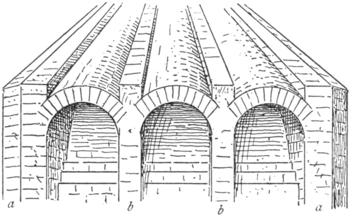of about 2½ metres, leaving an open space between it and the wall of the enclosing drum of 1.26 metres in width. Above this vertical portion the extrados is stepped by several courses of masonry, somewhat after the manner of the dome of the Pantheon.
From the reëntrant angles of the octagon (a, Fig. 6) solid abutments are built up against the salient angles of the vault, and, between these, two secondary abutments (b) are carried up against each of its sides. These buttresses are in the form of cross walls dividing the space on each side of the octagon into three compartments, and over each of these compartments a barrel vault, on an axis inclined in conformity with the slope of the roof, is turned. The upper ends of these vaults intersect on the surface of the dome, as shown in Figures 5 and 6. The voids between the crowns of these vaults and the buttresses are filled in with masonry so as to form the sloping planes of the roof below where it is incorporated with the dome, and on these are laid the slabs that form the external covering. With such an effective buttress system as is here provided it is hard to find a reason for the chain of timbers which is inserted at the haunch of the dome. The constructive principle embodied in this monument is altogether sound,[1] and its architectural character is in keeping with the construction.[2]
Such were the models of mediæval dome building accessible to Brunelleschi when he was forming his great scheme for the covering of the octagon of the cathedral of Florence. But the idea of a low dome, or a hidden dome, could not meet the wishes
- ↑ This needs to be qualified. The thrusts of the dome being continuous logically call for continuous abutment, as in the Pantheon, but the intervals between the abutting members are so small that the resistance is practically continuous.
- ↑ By its architectural character, I mean its character as a work of art. By the term "architecture" we properly mean not building merely, but the fine art of beautiful building.

